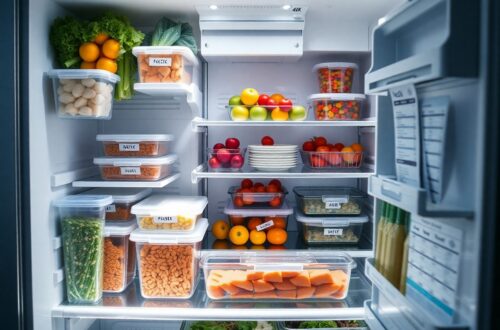There’s a direct link between the way you store food and your weight loss journey. By understanding the principles of proper food storage, you can extend the shelf life of your healthy choices, minimize waste, and avoid the temptation of unhealthy snacks. This guide will help you make informed decisions about how to store your foods effectively, ensuring that your weight loss efforts are supported by fresh, nutritious options at your fingertips. Let’s investigate the techniques that can help transform your kitchen into a weight loss ally.
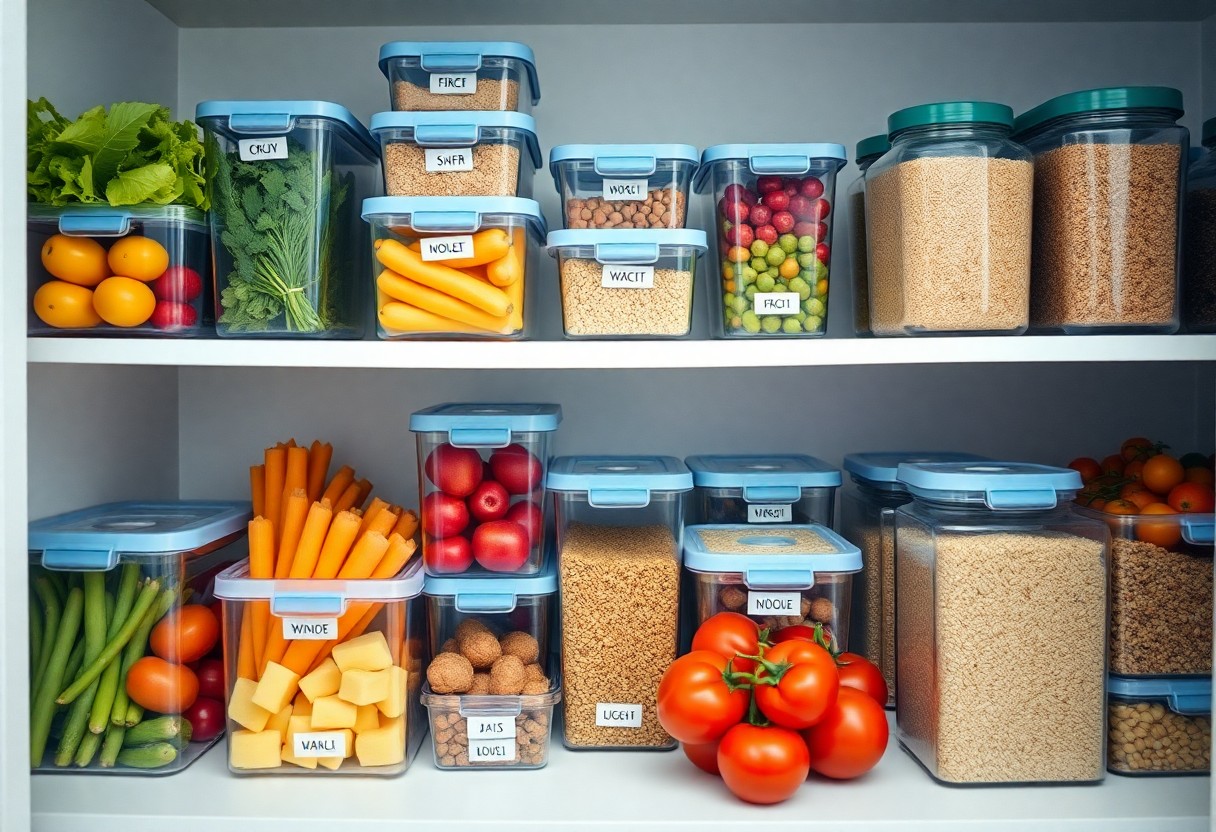
Key Takeaways:
- Organize your pantry and refrigerator to make healthy choices easier.
- Label your food items with dates to ensure you consume them in a timely manner.
- Utilize airtight containers to extend the freshness of your foods and prevent spoilage.
- Plan your meals in advance to avoid impulsive eating and maintain portion control.
- Freeze leftovers and extra portions to keep them from going to waste and provide quick meal options.
- Separate healthy snacks from less nutritious options to promote better eating habits.
- Monitor serving sizes and keep healthy foods in easy-to-reach places to encourage mindful eating.
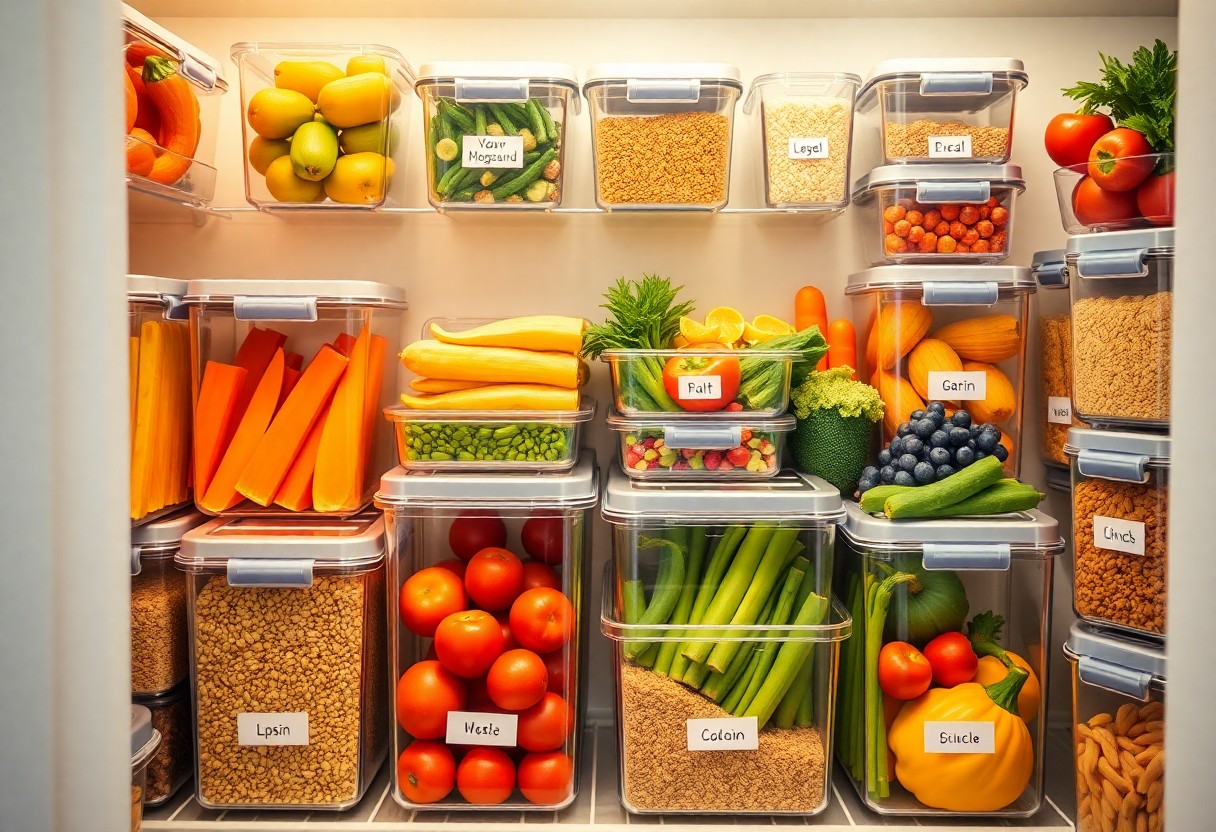
The Importance of Food Storage for Weight Loss
To achieve weight loss success, effective food storage is crucial. Properly stored food helps you maintain its nutritional value, prevents spoilage, and allows you to make healthier choices. When you organize your foods and know how to preserve them, you reduce the temptation to reach for unhealthy snacks, ensuring that your weight loss journey stays on track. Optimizing your food storage creates an environment where healthy eating is accessible and achievable, helping you navigate your goals with greater ease.
Understanding Food Lifespan
The lifespan of different foods varies significantly, influencing how long you can store them without losing quality. Perishable items such as fruits and vegetables generally have shorter shelf lives and require proper refrigeration. In contrast, dry goods like grains and legumes can last much longer if kept in airtight containers. Understanding these differences allows you to plan your meals effectively, minimizing waste and ensuring you consume fresh, nutritious food at the right times.
Preventing Waste and Overeating
Beside encouraging healthy eating habits, effective food storage helps in preventing waste and overeating. When you organize your food and are aware of its lifespan, you can prioritize consuming items before they spoil, reducing unnecessary waste. Additionally, knowing what you have on hand can curb impulsive decisions to grab unhealthy snacks. By managing portion sizes through proper storage, you contribute to your weight loss goals by minimizing caloric intake and maximizing nutritional benefits.
Waste not only impacts your wallet but also your dietary success. By taking steps to store food properly, you can track what you have on hand, avoiding the pitfalls of purchasing excess food that may go bad. This vigilance not only fosters mindful eating practices but also supports your commitment to weight loss. Using transparent containers and labeling items with expiration dates ensures you are aware of what needs to be consumed first, encouraging portion control and reducing the likelihood of overeating.
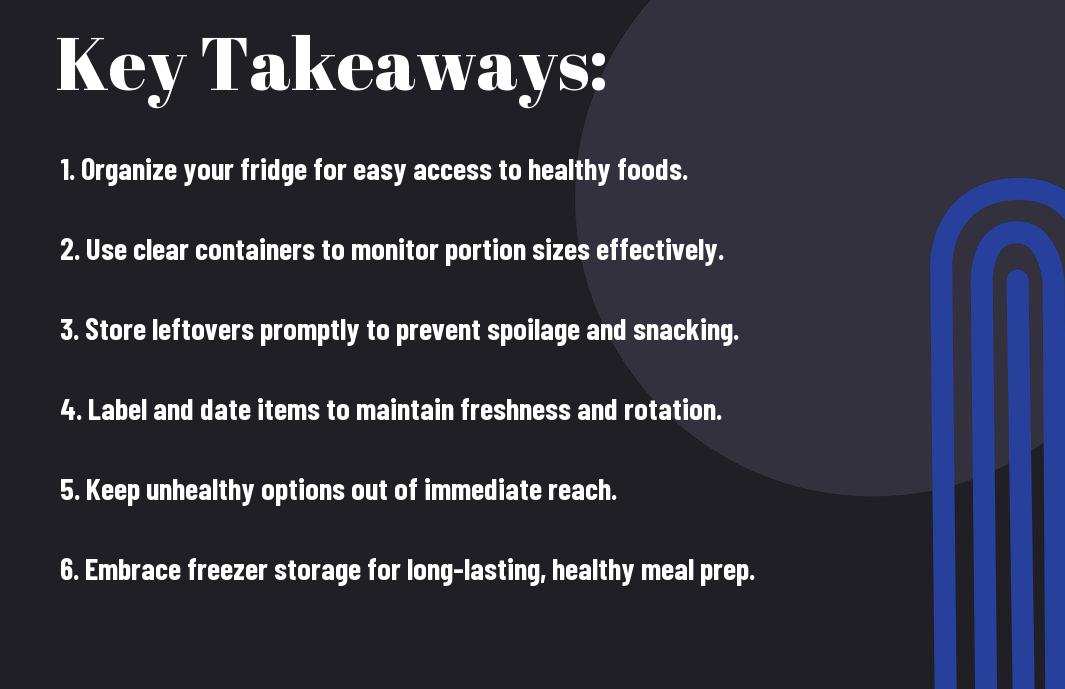
Ideal Storage Conditions
Any weight loss journey can benefit from understanding ideal storage conditions for your food. Proper storage not only preserves freshness but also helps maintain the nutritional value of your ingredients. By keeping food in optimal conditions, you set yourself up for meal success and encourage healthier eating habits. You’ll find that your meals are more appetizing, which ultimately supports your weight loss goals.
Temperature Control
Ideal food storage temperatures can help improve food safety and longevity. Use the following guidelines for effective temperature management:
| Food Type | Recommended Temperature |
| Refrigerator | 32°F – 40°F (0°C – 4°C) |
| Freezer | 0°F (-18°C) or below |
| Room Temperature | Below 70°F (21°C) |
Moisture Management
Temperature plays an imperative role, but moisture control is equally significant when it comes to food storage. Keeping your food in dry conditions helps prevent spoilage and bacterial growth, ensuring your meals stay fresh.
Even small amounts of excess moisture can lead to mold and food degradation. To combat this, store your dry goods in airtight containers and avoid exposing perishables to humid environments. Regularly check your storage areas for moisture buildup to maintain a safe and healthy food supply. Keeping things dry will prolong the life of your food and support your weight loss journey effectively.
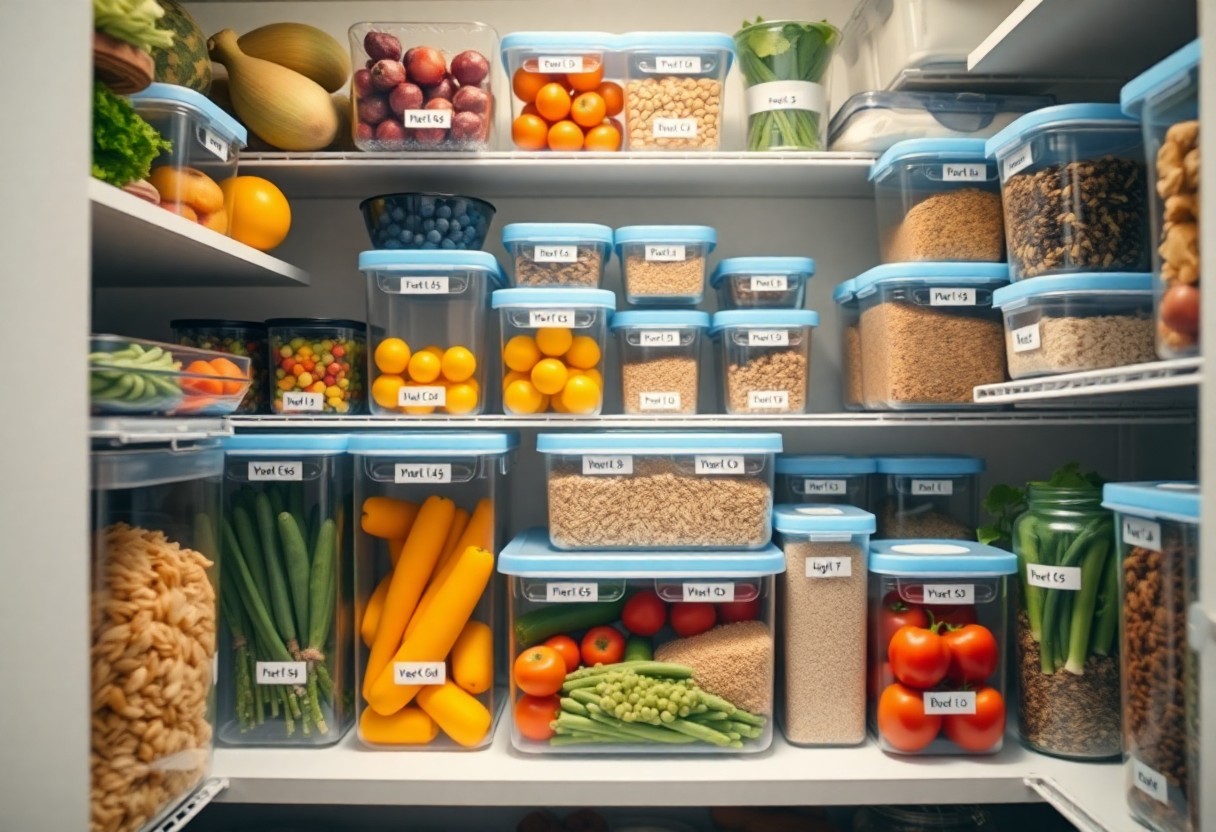
Types of Food Storage Containers
After understanding the importance of food storage, it’s imperative to choose the appropriate containers for your needs. Various food storage containers can help maintain food quality and assist in your weight loss journey:
- Glass Containers
- BPA-free Plastic Containers
- Silicone Bags
- Airtight Jars
- Vacuum Seal Bags
Knowing the type of container that best suits your lifestyle can streamline your meal prep and keep your food fresh.
| Container Type | Best For |
| Glass | Microwave and oven use |
| Plastic | Lightweight and portable options |
| Silicone | Freezing and baking |
| Airtight Jars | Long-term storage |
| Vacuum Seal | Maximizing freshness |
Glass vs. Plastic
Food storage containers come in different materials, with glass and plastic being the most popular. Glass is durable and non-toxic, making it an excellent choice for reheating and meal prepping. Plastic, particularly BPA-free options, are lightweight and versatile, making them easier to transport. Each material has its advantages, so it’s wise to choose the one that aligns with your specific needs and lifestyle.
Benefits of Airtight Containers
At the heart of effective food storage are airtight containers, which play a vital role in keeping your food fresh. These containers prevent air, moisture, and pests from affecting your meals, which is imperative for maintaining quality.
To achieve optimal food preservation, using airtight containers can help in prolonging shelf life, reducing food waste, and retaining flavors and nutrients. By sealing your meals properly, you not only save money but also stay committed to your weight loss goals by ensuring your food remains both fresh and delicious. This level of organization will streamline your meal planning and make it easier to stick with healthy choices.
Organization Strategies for Success
Many successful weight loss journeys begin with effective organization strategies. Keeping your food storage clean and well-organized not only saves time but also helps you stick to your goals. By neatly arranging your groceries, you can quickly find healthy options and resist the temptation of unhealthy snacks. A solid organization system sets the stage for mindful eating and prepares you for meal prep, making it easier to achieve weight loss success.
Fridge and Pantry Layout
Any well-structured kitchen layout enhances your ability to make healthier choices. Place nutritious foods like fruits and vegetables at eye level in your fridge, while keeping processed and high-calorie items out of sight. In your pantry, group similar items together, such as grains, snacks, and canned goods, to streamline meal prep and reduce decision fatigue.
Labeling and Inventory Management
Along with a tidy layout, effective labeling and inventory management can significantly aid your weight loss efforts. By labeling containers and jars, you’ll not only easily identify contents but also monitor portion sizes. Keeping an inventory of your pantry and fridge ensures you know what you have, reduces food waste, and encourages you to use up perishable items before they expire.
Pantry organization goes beyond simple labeling; it also involves tracking expiration dates and quantities. By jotting down a quick inventory on a notepad or using an app, you can spot when items are low and need replenishing. This proactive approach prevents forgotten foods from going bad and keeps your meal planning efficient, ensuring you always have healthy options readily available. Regularly checking and updating your inventory will empower you to make mindful grocery decisions that align with your weight loss goals.
Meal Prep and Portion Control
Keep your weight loss goals on track by mastering meal prep and portion control. Organizing your meals in advance not only saves time but also allows you to stick with healthier options. For expert guidance, check out 3 Expert Tips To Organize Your Pantry For Weight Loss ….
Preparing Foods in Advance
Meal prepping is an effective strategy that helps you stay committed to healthy eating. By cooking large batches of nutritious meals and storing them in portioned containers, you eliminate the temptation of unhealthy last-minute choices. This process also simplifies your week by giving you ready-to-eat options, ensuring you maintain control over your diet.
Portioning for Balanced Meals
Along with meal prep, portioning your food plays a significant role in achieving balanced meals. Understanding serving sizes is important for managing calorie intake and ensuring you’re getting the right nutrients.
Also, you can utilize tools like measuring cups, food scales, or portion-control containers to help you gauge appropriate serving sizes. Aim to fill half your plate with vegetables, a quarter with lean proteins, and a quarter with whole grains to promote balance. This method not only aids in weight loss but also fosters a healthier relationship with food.
Common Food Storage Mistakes to Avoid
For successful weight loss, proper food storage is crucial, but many people make common mistakes. You may find yourself falling into traps such as overcrowding your fridge or neglecting leftovers, which can lead to waste. To get started on your meal prep journey and improve your food storage habits, check out this How To Start Meal Prepping To Lose Weight guide.
Misuse of Containers
Food storage containers are an important factor in keeping your meals fresh. Make sure you are using the right type for the food you have; for example, airtight containers keep your produce crisp and prevent spoilage.
Erroneous Expiration Dates
Common misconceptions about expiration dates can lead to unnecessary waste. Many consumers throw away perfectly good food simply because the date has passed.
Understanding food labeling is crucial for effective storage. ‘Sell by’ and ‘use by’ dates can be misleading, so familiarize yourself with these labels. Many foods remain safe and fresh for days or even weeks after these dates, significantly enhancing your meal prep effectiveness while minimizing waste. Look for signs of spoilage instead, like odor or discoloration, to assess food safety.
Final Words
Upon reflecting on your weight loss journey, implementing proper food storage techniques can significantly enhance your efforts. By organizing your fridge and pantry, you can reduce food waste, keep healthier options readily available, and maintain portion control. Investing time in meal prep and utilizing appropriate containers not only preserves food quality but also encourages mindful eating habits. Ultimately, these practices empower you to make smarter food choices, aligning your daily habits with your weight loss goals for lasting success.
FAQ
Q: Why is food storage important for weight loss?
A: Proper food storage helps keep your meals fresh and safe to eat, reducing waste and saving money. By maintaining the quality of your food, you’re more likely to stick to your weight loss plan, as fresh and appealing meals are more enticing, which can help curb the temptation to stray from healthy options.
Q: What are the best ways to store fresh produce?
A: Fresh produce should generally be stored in the refrigerator to maintain its freshness. Leafy greens can benefit from being wrapped in a damp paper towel before being placed in a plastic bag, while fruits like apples and berries should be kept in ventilated containers. On the other hand, bananas and tomatoes do better at room temperature. Always check for any signs of spoilage before consumption.
Q: How should I store portions of protein like meat and fish?
A: Meat and fish should be stored in airtight containers or vacuum-sealed bags to prevent exposure to air, which can lead to freezer burn. Ideally, they should be kept in the coldest part of the refrigerator for short-term storage or frozen for longer storage. Use a refrigerator thermometer to ensure the temperature remains safe, ideally at or below 40°F (4°C).
Q: What is the best way to store leftovers?
A: Leftovers should be cooled to room temperature before transferring them to airtight containers. Label the containers with the date of storage to keep track of freshness. They can be stored in the refrigerator for up to three to four days. For longer storage, it’s advisable to freeze leftovers and consume them within three months to maintain taste and safety.
Q: Should I freeze or refrigerate prepared meals for meal prep?
A: Prepared meals can be refrigerated if you plan to eat them within a few days. However, if you want to keep them for a longer period, freezing is a better option. When freezing, ensure meals are in airtight containers or freezer bags, removing as much air as possible to prevent freezer burn. Portioning meals can also make it easier to grab a healthy option when you’re in a rush.
Q: How can I maintain the freshness of dry goods like grains and nuts?
A: Dry goods should be stored in airtight containers to protect them from moisture and pests. Ideally, they should be kept in a cool, dark place away from heat sources. Whole grains, nuts, and seeds may also benefit from refrigeration or freezing to help extend their shelf life, particularly if they contain natural oils that can go rancid over time.
Q: What common food storage mistakes should I avoid?
A: Common mistakes include overpacking the refrigerator, which can obstruct airflow, and not cleaning storage containers properly, leading to bacterial growth. Additionally, ignoring expiration dates can result in consuming spoiled food. Another mistake is not storing food at appropriate temperatures, which can compromise food safety. Regularly organizing your pantry, fridge, and freezer can help keep track of what you have and what needs to be consumed first.



